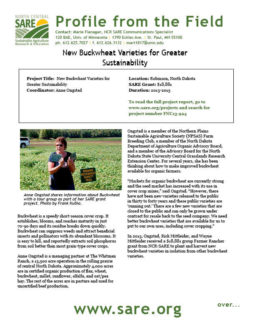Buckwheat is a speedy short-season cover crop. It establishes, blooms, and reaches maturity in just 70-90 days and its residue breaks down quickly. Buckwheat can suppress weeds and attract beneficial insects and pollinators with its abundant blossoms. It is easy to kill, and reportedly extracts soil phosphorus from soil better than most grain-type cover crops.
Anne Ongstad is a managing partner at The Whitman Ranch, a 13,500 acre operation in the rolling prairie of central North Dakota. Approximately 4,000 acres are in certified organic production of flax, wheat, buckwheat, millet, sunflower, alfalfa, and oat/pea hay. The rest of the acres are in pasture and used for uncertified beef production.
Ongstad is a member of the Northern Plains Sustainable Agriculture Society (NPSAS) Farm Breeding Club, a member of the North Dakota Department of Agriculture Organic Advisory Board, and a member of the Advisory Board for the North Dakota State University Central Grasslands Research Extension Center. For several years, she has been thinking about how to make improved buckwheat available for organic farmers.
“Markets for organic buckwheat are currently strong and the seed market has increased with its use in cover crop mixes,” said Ongstad. “However, there have not been new varieties released to the public in thirty to forty years and these public varieties are ‘running out.’ There are a few new varieties that are closed to the public and can only be grown under contract for resale back to the seed company. We need better buckwheat varieties that are available for us to put to our own uses, including cover cropping.”
In 2013, Ongstad, Rick Mittleider, and Wayne Mittleider received a $18,881 group Farmer Rancher grant from NCR-SARE to plant and harvest new buckwheat varieties in isolation from other buckwheat varieties.
In addition to these three farmers, Carmen Fernholz at the University of Minnesota Southwest Research and Outreach Center in Lamberton, MN; Steve Zwinger at the NDSU Carrington Research Extension Center; Pat Carr at the NDSU Dickinson Research Extension Center; and Kevin Murphy, a breeder at the Department of Crop and Soil Sciences at Washington State University in Pullman, WA, are carrying out small plot evaluations in association with the project
They are taking photos of the plots and providing data from organic and conventionally managed plots. They are measuring yield, seed counts, lodging, days to flowering, and taking notes on maturity, weeds, and canopy cover.
The research is ongoing, but Ongstad says the team intends to work with fellow members of the NPSAS Farm Breeding Club to discuss the importance of their findings and consider making the seed of promising new varieties available to the public via Farm Breeding Club seed sales. They also intend to provide samples of each variety to the USDA National Plant Germplasm System for breeders and other growers to use.
View Anne's presentation on this project, from the 2015 Farmers Forum, through NCR-SARE's YouTube playlist. Visit www.youtube.com/NCRSAREvideo for this and other videos.
